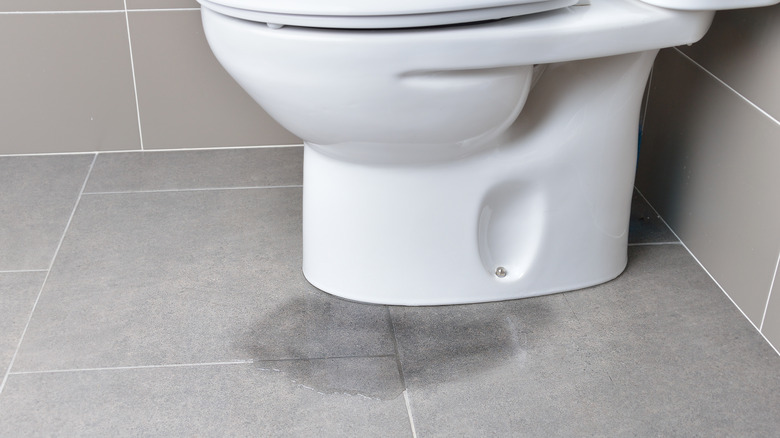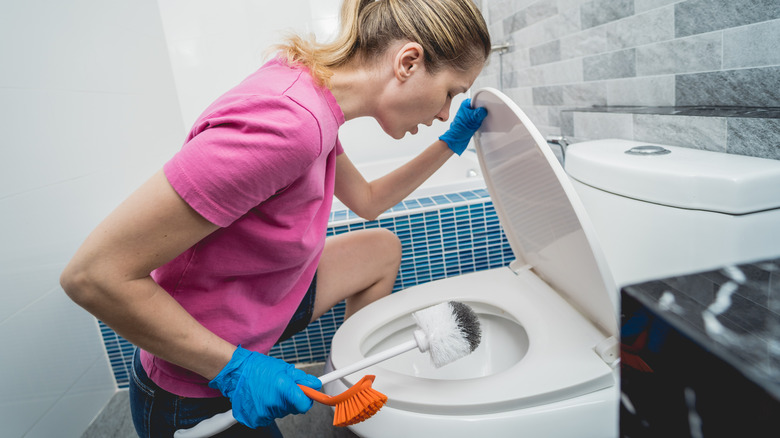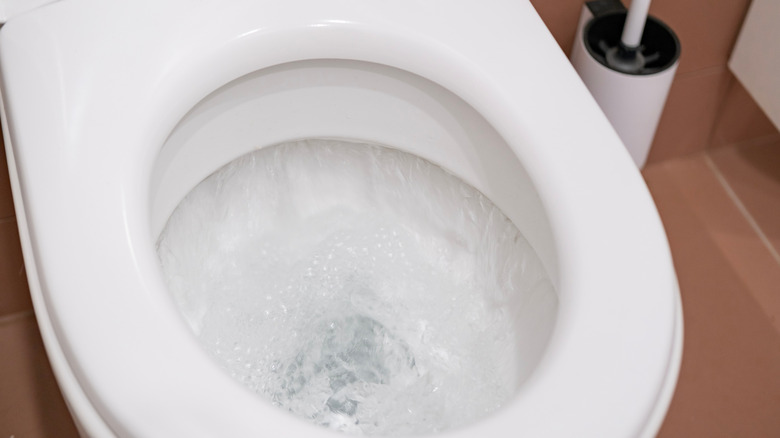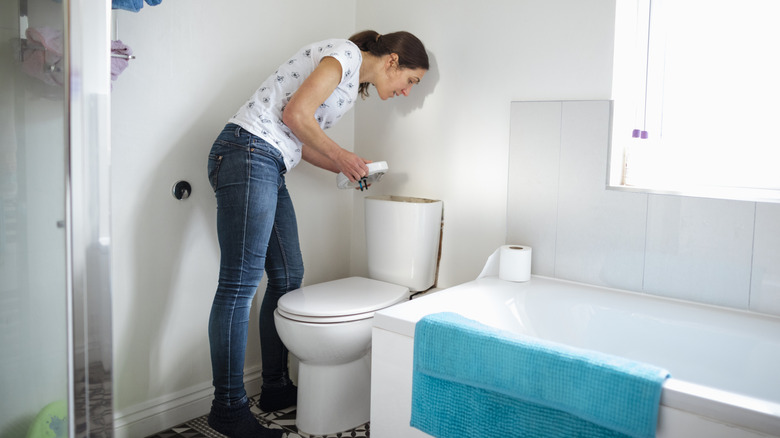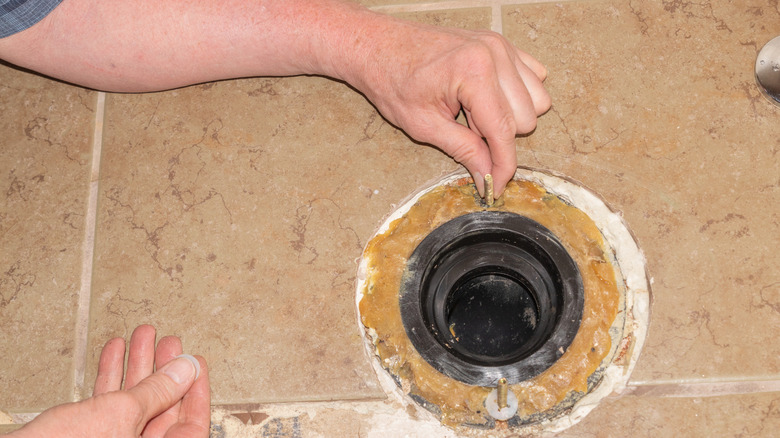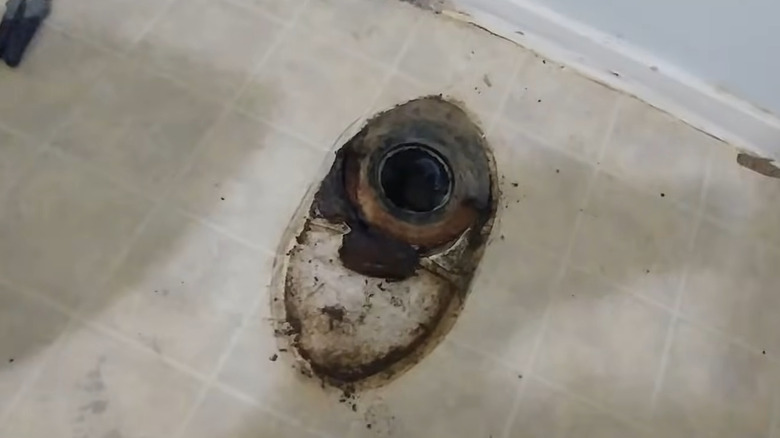10 Signs It's Time To Replace Your Toilet's Wax Ring
We may receive a commission on purchases made from links.
As the old saying goes, "Nothing lasts forever." Any homeowner can attest to the truth of the sentiment, as everything in a home eventually needs to be replaced. If you stay in a home long enough, you'll have to replace everything from flooring and fixtures to windows and water heaters. While the decision to replace your toilet's wax ring is on a completely different level than replacing your roof, it can still be an annoying problem, and you may have to call a plumber if it's something outside of your DIY wheelhouse. Even though an Oatey Heavy Duty Wax Bowl Ring costs just under $6, changing wax rings can be a pain in the neck, and it's a good idea to be sure that's the actual problem before taking your toilet apart.
Together with toilet flanges, wax toilet rings play an important role in keeping toilets sealed to the floor. Proper seals prevent flushed waste from draining or seeping into your bathroom, causing damage to your home and creating unsanitary conditions. The airtight seal created by a wax toilet ring also prevents dangerous septic gas from escaping into your living areas.
As we'll discover, there are several indicators that your toilet's wax ring is bad, including obvious signs like pooling water and foul smells. Some other signs are less common, but since wax rings can last 30 years or more, it's not always the first problem people suspect when issues like gurgling noises and water stains on the ceiling below first appear.
Water pooling around the base
One of the most obvious signs that your wax ring has failed is water pooling around the base. Since water can cause damage to flooring and subfloors relatively quickly, this isn't a problem you should ignore. One mistake people make is using caulk if they see water appear; that's not the answer to this problem, although you can use caulk around the base of a toilet for other reasons. In this case, caulk can trap leaking water under the floor, and before you know it, your floor is ruined.
Foul sewer odors
If you've been cleaning and cleaning and your toilet still smells like sewage, it could be sewer gases leaking in due to a broken wax toilet ring. Since septic gases are toxic, this is another common problem that you should address right away. However, just be aware that there could be other factors causing this problem. Sewer odors in your bathroom can be caused by clogged lines, dry P-traps, and sulfur bacteria in water heaters. To address the problem, start with the simplest solutions first, including addressing problems like dried-out P-traps and worn-out toilet ring seals.
Toilet wobbling
Toilets that move around when you sit down don't just feel dangerous — they can actually create a safety hazard because they're at risk of tipping. An unstable toilet could be caused by a broken toilet flange or a bad toilet ring, but it could even be the result of an uneven floor. Starting with the easiest solution first, tighten the flange bolts and see if that helps.
Slow or incomplete flushes
Slow flushes are one of the first signs that there's something wrong with your toilet. From clogged pipes to blocked air vents, there can be many potential causes for slow flushing, but one that often gets overlooked is the wax toilet ring. Replacing the wax ring is one of the easier problems you could have, so before you investigate other potential problems, tighten down the flange bolts and consider when the last time the wax toilet seal was replaced. Also, don't forget that slow and incomplete flushes could also be signs you need your septic tank pumped.
Mold or mildew near the base
Small problems can become big disasters when leaky toilets lead to mold remediation. If you find mold or mildew near the base of your toilet, it's a sign that water is collecting there, and probably more than just the small amount that drains down from condensation on the outside of the bowl. If you think there's a possibility that mold or mildew is getting underneath your toilet, slip a piece of toilet paper under the base and flush. If it gets wet, your wax ring is leaking and needs to be replaced.
Gurgling sounds
There is a reason that homes have drain venting systems — it's because when water goes down the drain, it takes all the air with it, and it has to be replaced from somewhere. Abnormal gurgling sounds could indicate a problem caused by this negative air pressure, and it could even be caused by a cracked or worn wax toilet ring. Other causes include blocked vent stacks and clogged sewer lines.
Rusted or corroded flange bolts
Water is a well-known catalyst of rust, so if you have excessively rusted or corroded flange bolts, that means they've been in contact with water. Since the water seeping out from a broken toilet ring is sometimes not visible, as in the cases where it gets underneath the top layer of flooring, you may not notice there's a problem until the flange bolts are rusted. Since this weakens them and can cause them to break, they should be replaced as soon as possible to prevent further issues.
Floor is squishy near the toilet
If your floor is squishy near the toilet, it indicates serious problems that could be caused by a leaking wax toilet ring. Unfortunately, repairs for this problem are typically more extensive than simply replacing the wax seal. Unless you have a concrete floor, there's probably some type of wood in your subfloor, and the water damage to wood caused by even a small amount of water over a long period can be significant. Spongy flooring is a tell-tale sign of water damage, and could signal the need for repairing the entire floor and subfloor.
Damaged flooring around the toilet
There are several signs that the floor around your toilet is damaged, including discoloration and sponginess. This is the result of a toilet that has leaked for an extended period. If you take the toilet off, raise the floor, and replace the toilet, there's a gap between the floor and the toilet flange that the wax ring can't fill. Over time, it leaks small amounts of water under the new layers of flooring and can even cause water stains on the ceiling below.
Water stains on the ceiling below
When you see water stains on a ceiling, one of the first things you need to consider is if there are any toilets directly above. If a toilet is leaking from any point, including around the base and underneath multiple layers of flooring, the water can eventually make its way through insulation and drywall to stain the ceiling below. Unfortunately, by the time this has occurred, there may be a significant amount of damage.

